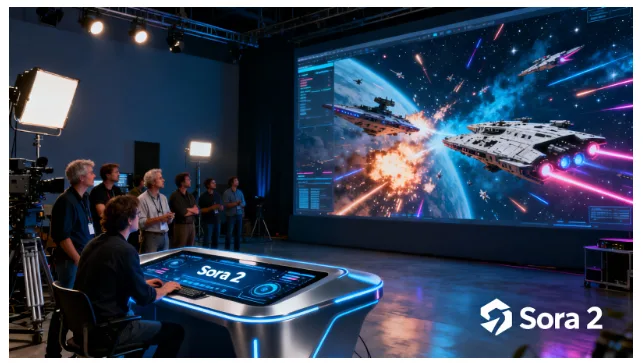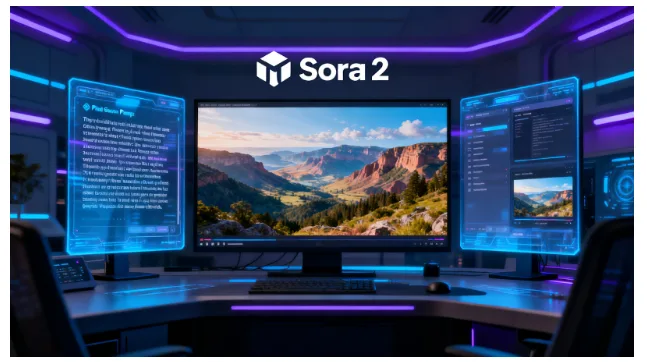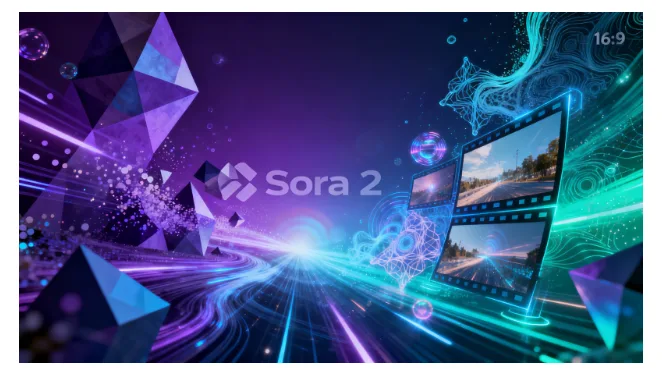From Silicon Valley Labs to Global Creators: How Sora 2 and Decentralized AI Design Tools are Bridging the Digital Divide
The democratization of artificial intelligence tools is reshaping who gets to tell stories in the digital age
For decades, high-quality video production remained the exclusive domain of well-funded studios and corporations. A 30-second commercial with sophisticated visual effects could cost upwards of $500,000, while feature film productions routinely allocated millions to post-production alone. This economic barrier has effectively silenced countless voices across emerging markets, where creative talent flourishes but capital remains scarce.
Today, a new generation of AI-powered tools is challenging this paradigm. As advanced video generation models like Sora 2 emerge from research laboratories, and accessible design platforms proliferate globally, a critical question surfaces: Can these technologies genuinely democratize creative production, or will they simply reinforce existing digital inequalities under a new technological veneer?
The answer may determine whether the next decade witnesses a genuine diversification of global media voices or merely a more efficient consolidation of creative power.

Sora 2: A Technical Leap with Global Implications
OpenAI’s Sora 2 represents a significant advancement in generative video technology, building upon diffusion model architectures and transformer-based systems that have revolutionized machine learning applications. Unlike its predecessors, Sora 2 demonstrates improved temporal coherence, extended video duration capabilities, and enhanced understanding of physical dynamics—technical achievements that translate into practical creative applications.
The implications extend far beyond Silicon Valley’s innovation ecosystem. Video content that traditionally required weeks of production time, specialized equipment, and teams of professionals can now be generated in minutes through text prompts. For educational institutions in Sub-Saharan Africa operating on constrained budgets, this technology could enable the rapid production of localized educational content. Media startups in Southeast Asia might produce news explainers and documentary segments without prohibitive production costs.
According to data from the International Telecommunication Union, internet penetration in developing regions reached 57% in 2024, yet content creation capabilities remain concentrated in wealthy nations. Tools like Sora 2 could theoretically narrow this production gap—if access barriers can be overcome.
However, video generation represents only one component of comprehensive content production. A 60-second AI-generated video still requires thumbnails, title cards, branded elements, and promotional materials. The broader creative ecosystem demands equally accessible design tools to fully capitalize on video generation breakthroughs.
This reality points toward a pressing need: AI-powered design solutions that complement video tools while remaining accessible to creators operating outside traditional creative industry hubs.
The Missing Link: AI Design Agents for the New Creative Economy

While generative video captures headlines, the infrastructure supporting digital content creation requires equally transformative solutions. Small businesses in emerging markets face a compound challenge: limited access to professional designers, insufficient budgets for commercial design software, and tight timelines that traditional outsourcing cannot accommodate.
This gap has given rise to what industry observers term “AI design agents”—platforms that function as automated design partners rather than mere template generators. These systems leverage machine learning to produce custom visual assets, from user interface elements to complete brand identities, with minimal user expertise required.
Lovart.ai exemplifies this emerging category of tools. Operating as an AI-powered design platform, it addresses the practical bottleneck many creators encounter when attempting to leverage advanced video generation capabilities. The platform’s approach centers on cost-efficiency and workflow simplification—critical factors for adoption in resource-constrained environments.
To address the gap in accessible design assets for the AI video era, platforms like Lovart.ai offer a crucial bridge for creators. For organizations exploring tools like Sora 2 design assets, the ability to rapidly generate high-quality visual elements—from video thumbnails to branded graphics—becomes essential. The platform enables even small organizations to develop complete visual ecosystems that complement AI-generated video content, something previously requiring dedicated design teams or substantial outsourcing budgets.
The economic implications merit attention. According to estimates from development economists, small and medium enterprises in emerging markets allocate approximately 60% less capital to design and branding compared to counterparts in developed economies—not due to lack of recognition of its value, but purely due to resource constraints. AI design agents potentially compress costs by an order of magnitude while maintaining quality standards.
The platform’s focus on removing technical barriers proves particularly significant for emerging market adoption. Many creators in regions like Latin America, Southeast Asia, and East Africa possess strong creative vision but lack formal training in professional design software. By minimizing the learning curve while maximizing output quality, such platforms enable a broader spectrum of global voices to participate in the digital content economy.
Moreover, the integration between video generation and design workflows represents a more holistic approach to creative democratization. When a Nigerian entrepreneur can generate promotional video content and immediately produce accompanying social media assets, website banners, and presentation materials through a unified AI-driven process, the compound effect multiplies creative output potential exponentially.
The Governance Challenge: Technology’s Double-Edged Nature

The proliferation of powerful generative AI tools inevitably raises complex ethical and societal questions that international news organizations and development agencies have begun examining closely. Sora 2 and similar video generation systems possess capabilities that extend beyond legitimate creative applications into potentially harmful territories.
Deepfake technology—the creation of convincing but fabricated video content—presents obvious risks to information integrity, particularly in regions where media literacy remains limited and democratic institutions face pressure. The 2024 election cycles across multiple continents demonstrated how even crude manipulated media could influence public opinion. More sophisticated tools exponentially amplify these risks.
Copyright and intellectual property frameworks, largely developed for pre-digital creative economies, struggle to address AI-generated content. When a generative model produces video incorporating stylistic elements from thousands of existing works, determining ownership and appropriate compensation becomes legally and ethically complex. Creators in developing nations, often operating without robust legal protection, may prove particularly vulnerable to exploitation.
Labor market disruptions present another dimension of concern. While AI tools promise to empower independent creators, they simultaneously threaten traditional creative sector employment. Graphic designers, video editors, and visual effects artists—professions that have provided middle-class livelihoods across developing economies—face uncertain futures as automation advances.
Responsible development and deployment of these technologies requires proactive governance frameworks. Technology companies developing AI design and video tools bear responsibility for implementing safeguards: content provenance systems that allow tracking of AI-generated materials, usage policies that prohibit malicious applications, and transparent disclosure of training data sources.
International organizations and civil society must equally engage. The United Nations, through bodies like UNESCO and the International Telecommunication Union, has begun convening stakeholders to develop global AI governance standards. Regional organizations across Africa, Asia, and Latin America should actively participate in these dialogues, ensuring that governance frameworks reflect diverse perspectives rather than merely exporting Western regulatory models.
Equitable access must remain central to these conversations. If governance approaches inadvertently create barriers that only well-resourced organizations can navigate, they risk reinforcing the very inequalities that democratization efforts aim to address.
Toward an Inclusive Creative Future
The emergence of Sora 2, Lovart.ai, and similar AI-powered creative tools represents a genuine inflection point in global content production. These technologies are not merely incremental improvements to existing workflows—they fundamentally alter the economics and accessibility of professional-quality creative output.
Yet technology alone cannot guarantee equitable outcomes. The digital divide encompasses not only access to tools but also digital literacy, reliable internet infrastructure, and supportive policy environments. A creator in rural Indonesia with access to Sora 2 but no reliable broadband connection cannot fully participate in the AI-enabled creative economy.
Stakeholders across sectors bear responsibility for ensuring this technological moment translates into genuine opportunity rather than exacerbated inequality. Governments in developing nations should prioritize digital infrastructure investment and integrate AI literacy into educational curricula. Technology companies must design platforms with emerging market users as primary rather than secondary considerations, accounting for connectivity constraints, diverse linguistic needs, and varied cultural contexts.
International development organizations can play a catalytic role by supporting capacity-building initiatives that help creators in underserved regions effectively utilize these tools. Training programs, mentorship networks, and showcase platforms that elevate work from diverse global sources all contribute to a more inclusive creative ecosystem.
The next chapter of the AI revolution in creative industries will be written not by the technologies themselves, but by the choices stakeholders make regarding access, governance, and support structures. If these choices prioritize equity alongside innovation, tools like Sora 2 and AI design platforms may indeed bridge long-standing digital divides. If they do not, these powerful technologies risk becoming yet another mechanism through which existing advantages compound.
The opportunity exists. Whether it will be realized depends on actions taken today by technologists, policymakers, educators, and the global creative community itself.
